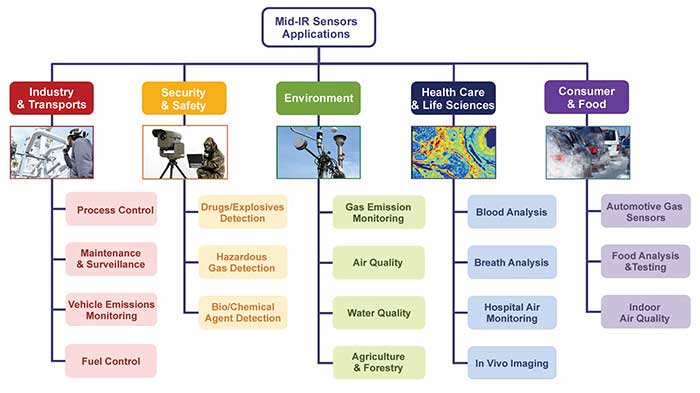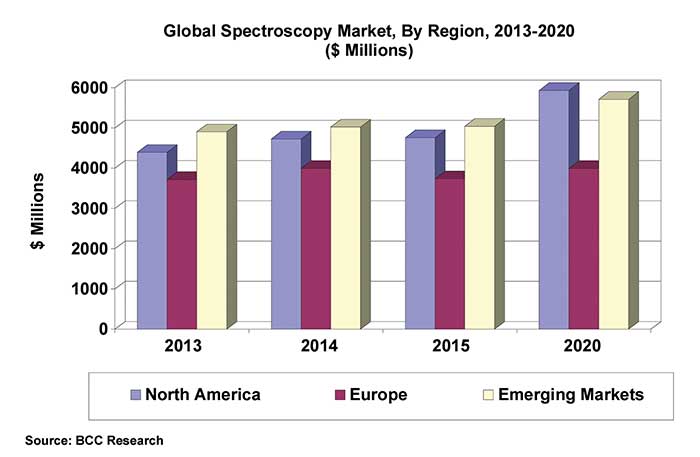Growth over the next four to five years is anticipated across several sectors, with CAGR estimates ranging from 6.5 percent a year for IR spectroscopy to 10 percent for Raman.
Novel advances in bio- and health care-related fields, and the growing demand for them, are driving the spectroscopy market to higher levels. Several subsets of this market are approaching the billion dollar level globally, with increasing applications specifically in pharmaceuticals and the life sciences.

Mid-IR is expected to hold the largest share of the growing
spectroscopy market through 2022, with an expansion of health care and
life science applications slated to be a driving force. Courtesy of
TEMATYS.
Technologies across several spectroscopy sectors are emerging as influential contributors to this market growth. These include molecular, process, Raman, and several levels of infrared.
The growing market
IR spectroscopy — categorized mainly into near-IR, mid-IR and far-IR — is employed in applications in biological-related areas, among others, and it’s a submarket that is expecting substantial growth, according to MarketsandMarkets, an international market research company. The pharmaceuticals sector, in particular, “held the largest share of the IR spectroscopy market in 2015, while the market for the biological and chemicals sectors is expected to grow at a significant rate between 2016 and 2022.”
A 2016 report by MarketsandMarkets determined that overall the IR spectroscopy market should top $1.26 billion by 2022, at a compound annual growth rate (CAGR) of 6.5 percent. Cited as a particular key player within this market, the area of mid-IR is expected to hold the largest market share through 2022, thanks, in part, to research applications. An increasing demand for near-IR spectroscopy devices is pushing this submarket toward significant growth, as well.
Among such devices, according to MarketsandMarkets’ report, is the portable spectroscope. It is “expected to grow at a higher rate than that of the other IR spectroscopy [technology],” given its capacity to improve workflow, minimize space requirements, and offer less complications as well as improvements relating to maintenance. Fourier Transform Infrared (FTIR) spectroscopy is another evolving area of the IR submarket, expected to see high growth and demand through 2021. Portable FTIR spectrometers — used for analysis and testing applications in pharmaceuticals and other such sectors — are becoming more common in research settings; demand for such products is contributing to this submarket’s growth.
North America held the largest share of the IR spectroscopy market in 2015, according to market research firm RnR Market Research, and it’s expected to continue dominating this sector over the next five years. This is due, in part, to increases in government funding for research, as well as stringent drug regulations. RnR also cites the Asia-Pacific region as one that will see ample growth, and at the highest rate through 2022.

Global Spectroscopy Market, By Region, 2013-2020. Courtesy of BCC Research.
The molecular spectroscopy sector has been on the rise globally, according to a 2016 report by Data Bridge Market Research. By 2022, it is poised to reach $7.6 billion, at a CAGR of 6.3 percent; this submarket was valued at $4.9 billion in 2015.
Molecular spectroscopy — defined as “spectrum analysis concerned with the spectra formed by transitions in molecules” — finds applications in biotechnology and biopharmaceuticals, and is commonly used in academic research. North America is the largest market for molecular spectroscopy, with a nearly 48 percent market share, according to Data Bridge, thanks to “increasing metabolomics research and large investments in health care.” The Asia-Pacific region is expected to grow at the highest CAGR over the next several years, as “large pharmaceutical companies are outsourcing their manufacturing to emerging markets such as China and India.”
The market for process spectroscopy — any use of spectroscopy to obtain real-time data to monitor and optimize a manufacturing process — is also expected to see notable growth. This market “reflects the rising awareness for quality throughput among end-use industries such as oil and gas, pharmaceuticals, and food and agriculture,” according to information from Radiant Insights Inc., a research and consulting company.
Experts there anticipate that the process spectroscopy market will hit $1.27 billion by 2022, growing annually by nearly 9 percent. MarketsandMarkets cites the pharmaceutical industry as a key end-use segment for such market growth; specifically, an increased focus on drug safety regulations, “where process spectroscopy techniques enable the detection of metals in drug samples.”
Raman spectroscopy is yet another submarket that should experience significant growth over the next several years. This sector is expected to grow nearly 10 percent annually through 2021 to reach $1.8 billion, according to a 2016 study by market research firm ReportLinker. It topped out at $1.1 billion in 2016. The life sciences is the largest application area for Raman spectroscopy; this area alone is on target to reach $658 million by 2021.
“Probe-based Raman spectroscopy accounts for the largest share of the market in terms of instrument sales, and this product segment is expected to continue to lead the market throughout the forecast period,” said BCC Research analyst Sinha Gaurav. “In terms of sampling techniques, surface-enhanced Raman scattering (SERS) accounted for the largest market share, with 40.9 percent of the global market in 2015.”
Driving forces
The growth of near- and mid-IR spectroscopy can be attributed to anticipated increases in government funding for R&D in North America, as well as potential changes in drug development regulations, according to MarketsandMarkets in a 2016 report. Advances in and the rise of bio-related research sectors such as proteomics could also contribute, the study notes, offering “a platform for key players to showcase new products and technologies.”
Market experts anticipate IR spectroscopy playing a key role in the pharmaceutical excipient manufacturing process. Growing acceptance of new international quality distribution and manufacturing practices is expected to increase the usage of IR spectroscopy instruments, thereby driving the growth of the market.
Increases in government funding for research, as well as stringent drug regulations, take partial credit for the significant growth of IR spectroscopy in North America, in particular. Development of the mid-IR sector of this submarket is the result of the advancement of research-focused and industrial applications.
The Raman spectroscopy market eyes growth thanks to technological advances in health care and research, as well as diagnostics. BCC’s Gaurav said that “increasing demand for real-time analysis of samples in the harshest conditions is expected to propel the demand for SERS during the [market] forecast period [2016-2021].”
The process spectroscopy market is being driven by similar forces — specifically technological advances and lower prices. Growth in this segment has also been attributed to the popularity of portable or handheld spectroscopy instruments. Additionally, the focus on reducing operational expenditure should further propel the evolution and adoption of process spectroscopy globally.
Progression of the spectroscopy market as a whole can be attributed to a rising interest in bio-related, eco-friendly technologies. BCC added that “R&D spending, increasing competition, patent expiries and new technologies are giving a direction to the [spectroscopy] market.” New product launches and changing lifestyles have also influenced the spectroscopy market to grow into the future.